A shopper wearing a protective face mask browses luxury handbags inside a Louis Vuitton boutique in Moscow, Russia.
Bloomberg | Getty Images
The coronavirus pandemic has put many industries into crisis mode, and luxury retail is one of them.
With fewer places to see and be seen, shoppers are slowing their spending, with an estimate from consultancy firm McKinsey forecasting the global luxury goods market will contract by 35% to 39% in 2020, year-over-year.
“Dressing up, buying new clothes and following fashions is incredibly dependent on social activities such as going to work, going out, having parties and simply being seen by others,” stated Vicky Bullen, CEO of branding consultancy Coley Porter Bell in an email to CNBC. “If you’re not seeing anyone, what’s the point?” she added.
Instead of showing off an upscale bag or car, which might feel too conspicuous when the U.S. economy is in a downward spiral, consumers are instead displaying their “wellness” during stay-at-home orders, according to Malinda Sanna, founder and CEO of consultancy Spark Ideas. “Health and vitality … kind of are the new luxury. Any sort of symbols or cues of that are entirely permissible,” she told CNBC by phone.
Spark Ideas undertook research with luxury buyers in cities in the U.S., as well as in Shanghai (to qualify, participants had to have spent at least $2,000 on a single fashion item in the past 12 months, for example), which revealed the popularity of high-end fitness equipment such as the Peloton bike. As well as being able to try different classes, one woman in the U.S. study said she was “in love” with the bike because of “the status it has with my friends.”
Family time was also seen as a source of joy by the study’s participants. “It’s definitely not about showing off acquisitions. Real privilege now is being with a pack, it’s being surrounded by loved ones, having them accessible. Being able to spend time with children and family that maybe, you know that time wasn’t available before,” Sanna stated.
Store pause
And as cities such as Shanghai open up more, shoppers aren’t necessarily flocking to brick-and-mortar outlets. Getting a temperature check and wearing a mask does not go well with browsing a luxury boutique, Sanna said. “All of that is not a luxury experience at all,” she told CNBC. Instead, brands that do well will be those whose sales associates have close relationships with their customers. “There are ways now that sales associates can text and reach out one on one to their highly valued customers. And those relationships are like gold right now.”
Goods that are set to do well post-pandemic are those that might be called “quiet luxury,” according to Rebecca Robins, global chief learning and culture officer at consultancy Interbrand Group. “We’re already seeing the resurgence of quiet luxury and understatement, as evidenced in the more timeless aesthetics of brands such as Hermès, Prada and Bottega Veneta,” she told CNBC via email.
Indeed, after the downturn of 2008-2009, some luxury brands were able to charge a lot more for certain items. The Hermes Kelly bag, named after Grace Kelly used one to hide her pregnancy from the paparazzi in 1956, retailed at upward of $4,800 in 2000, and by 2013 buying one set a shopper back $7,600 — a 58% increase in 13 years, per McKinsey’s estimates.
But even during the pandemic, people’s desire for high fashion wasn’t always dampened, Robins noted. When Nike collaborated with luxury label Dior to launch the Air Jordan 1 OG sneaker, more than 5 million people reportedly registered for the chance to buy a pair last month. “Some behaviors don’t change they become even more heightened. Rarity remains a powerful driver of desire,” she said.
And there could be better news ahead. Consumers are likely to return more quickly to paying the full price for upscale goods, as they did after the 2008 financial crisis, with positive growth of 1% to 4% expected in 2021, per McKinsey’s report. And while some consumers may have an eye on sustainability, buying “fewer, better things,” others will splurge.
“It’s going to be one big party and it’s going to be like nothing we’ve ever seen. And I think luxury brands, all brands, should be preparing for that,” according to Sanna.
